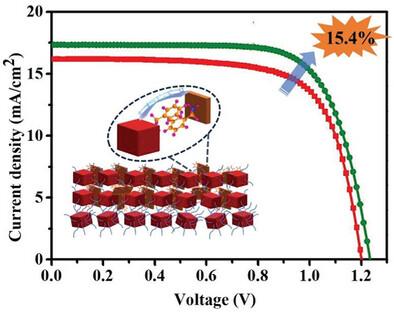Solvent-Mediated Growth of a Hierarchical Zero-Dimensional Architecture for Efficient CsPbI3 Quantum Dot Solar Cells
IF 13
2区 材料科学
Q1 CHEMISTRY, MULTIDISCIPLINARY
引用次数: 0
Abstract
Perovskite quantum dots (QDs) are promising optoelectronic materials. The large surface area provides an opportunity for ligand engineering to protect the QDs, while also impeding the charge transport in the QD array. Here, the solvent-mediated growth of a hierarchical zero-dimensional (HZD) architecture between CsPbI3 QDs is reported. The HZD architecture is grown on the CsPbI3 QD film through a feasible method rather than introducing intricate molecules into the CsPbI3 QD solution. Acetonitrile solvent with high polarity strips lead iodide from the QD surface, and then the lead iodide reacts with the phenethylamine iodide to form HZD architecture. The HZD architecture acts as a “charge bridge” to enhance the coupling between CsPbI3 QDs, resulting in improved photoelectric properties. As a result, the optimized device achieves a high-power conversion efficiency of 15.4%, remarkably higher than the 14% of the control device. This work demonstrates the significance of surface chemistry for perovskite QDs and provides a feasible strategy for realizing high-performance perovskite QDs-based optoelectronic devices.

过氧化物量子点(QDs)是一种前景广阔的光电材料。大表面积为配体工程提供了保护量子点的机会,同时也阻碍了量子点阵列中的电荷传输。本文报告了溶剂介导的 CsPbI3 QDs 之间分层零维(HZD)结构的生长。HZD 结构是通过一种可行的方法在 CsPbI3 QD 薄膜上生长出来的,而不是在 CsPbI3 QD 溶液中引入复杂的分子。高极性乙腈溶剂将碘化铅从 QD 表面剥离,然后碘化铅与碘化苯乙胺反应形成 HZD 结构。HZD 结构可充当 "电荷桥",增强 CsPbI3 QD 之间的耦合,从而改善光电特性。因此,优化后的器件实现了 15.4% 的高功率转换效率,显著高于对照器件的 14%。这项工作证明了表面化学对于包晶QDs的重要意义,并为实现基于包晶QDs的高性能光电器件提供了可行的策略。
本文章由计算机程序翻译,如有差异,请以英文原文为准。
求助全文
约1分钟内获得全文
求助全文
来源期刊

Small
工程技术-材料科学:综合
CiteScore
17.70
自引率
3.80%
发文量
1830
审稿时长
2.1 months
期刊介绍:
Small serves as an exceptional platform for both experimental and theoretical studies in fundamental and applied interdisciplinary research at the nano- and microscale. The journal offers a compelling mix of peer-reviewed Research Articles, Reviews, Perspectives, and Comments.
With a remarkable 2022 Journal Impact Factor of 13.3 (Journal Citation Reports from Clarivate Analytics, 2023), Small remains among the top multidisciplinary journals, covering a wide range of topics at the interface of materials science, chemistry, physics, engineering, medicine, and biology.
Small's readership includes biochemists, biologists, biomedical scientists, chemists, engineers, information technologists, materials scientists, physicists, and theoreticians alike.
 求助内容:
求助内容: 应助结果提醒方式:
应助结果提醒方式:


